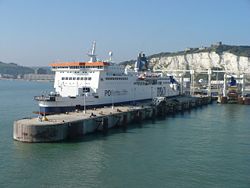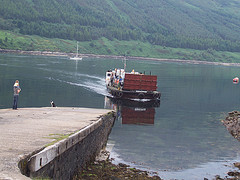Ferries
| Ferries | |
 | |
| P&O Ferry at Dover | |
| Pictures related to Ferries View gallery (9) | |
As Island Nations, ferries are very important to Britain and Ireland, not just in connecting our countries to each other and the rest of Europe, but also in linking the hundreds of islands along the coasts together. From the Channel Isles in the south to the Shetlands in the far north, ferries are an important part of everyday life for many people, and also add a spark of excitement to holidays for many more.
However, not all ferries are the same. They can range from tiny little boats capable of carrying a dozen or so passengers, and maybe a push bike or two, to huge ocean going cross-channel vessels which can carry hundreds of vehicles and thousands of passengers. Below are a few common types of ferry:
Passenger only ferries
This is the oldest type of ferry, originating as a simple rowing boat that would carry half a dozen or so fare-paying passengers at a time. Most have now been replaced by bridges, or at least vehicle ferries, but a few survive, primarily as tourist crossings. The vast majority (if not all) are now powered by engines, but the size of the boat can still vary significantly from the small boat operating on the Camusnagaul crossing from Fort William which is capable of carrying a couple of dozen people at the most, to the much larger boats operating on the John O Groats ferry to the Orkneys and those operating on the estuaries along the south coast, such as the Dartmouth-Kingswear Ferry.
Chain Ferries
Chain Ferries are another design that date back many centuries. They also go by the name of 'Floating Bridge'. An early form of Chain Ferry is seen crossing the Thames in the film 'A Knights Tale'. Here, the boat is hauled across the river by a man pulling a rope which normally resides on the river bed, but is dragged up and over pulley wheels as the boat crosses. Modern Chain Ferries are powered by engines, but still rely on a permanent cable on the river bed, which is lifted and passes through some form of pulleys to drag the boat back and forth.
The benefits of such a system are that the boat is guided across the river, minimising the effects of the tide or wash from passing ships. This largely eliminates the need for a skilled driver to steer the ferry according to the current, instead it is only a manner of operating a brake, and in modern chain ferries this can even be controlled by 'signals' on the cable either mechanically or via computer control.
Turntable Ferries
The earliest type of car ferry was little more than planks across a rowing boat which allowed one car at a time to cross. These were once a common sight in the Scottish Highlands, although most routes have now been superseded by bridges. A development of this, providing a slightly more stable vessel, was to mount a turntable on the boat, allowing the car to be spun around so that it sat lengthways during the crossing.
The ultimate development was a much larger boat where a number of vehicles can be driven on board, facing the wheelhouse. The whole vehicle deck is then rotated 180degrees, generally without too much effort if the deck is loaded skillfully, and so the vehicles can again drive off forwards at the other side. The last remaining such vessel still operates on the Glenelg - Kylerhea Ferry crossing to Skye in the summer months.
Lift on Ferries
A strange hiccup in car ferry design was the lift on ferry. Whilst drive-on ferries had been in use for many years, in the post war era when travelling and touring by car (either for holiday makers, or island residents) was increasing rapidly, a number of ferry operators were slow to react. The compromise used on many crossings in the Scottish Hebrides in particular was to effectively treat a car as freight, and so use the existing derrick cranes to lift the cars into the hold on slings. Obviously, this was a very time consuming business, and largely unsuitable for heavy lorries and buses, meaning that all cargo had to be man-handled at both ends.
By the 1960s, these older ships were coming to the end of their lives, and their replacements were the ro-ro ferries that we still have today. However, a couple of lift on ferries still operate in the Orkneys and Shetlands, operating on services where cars are rarely carried.
Roll-on Roll-off Ferries
Roll-on Roll-off (ro-ro) Ferries began to be introduced during the rise of motor traffic in the mid-20th century are the most common design today. Prior to this, vehicles travelling abroad would need to be lifted onto the ferry directly by crane.
Early ships had side-entrance ramps, but most modern ferries have bow and stern doors allowing a straight drive-through service. Even modern Catamaran Ferries, where a bow entrance is virtually impossible, have been designed for ro-ro, as the vehicle decks either loop or spiral around inside the vessel, allowing cars to drive straight through and depart alongside the entrance ramp. A number of small crossings still operate single-ramp ferries, where vehicles need to reverse on, and so drive off at the other side. However such ferries rarely carry more than a dozen vehicles these days, as the proper ro-ro ferries have taken over.
The popularity of ro-ro ferries have reduced the demand for traditional boat-train services. For example, after the port at Dún Laoghaire closed in 2014, foot passenger traffic must now make a 3km bus or taxi ride from the ferry terminal at Dublin to the city centre. Similarly, the integrated rail / ferry terminal at Stranraer closed in 2011, with services moving to the more ro-ro compatible Cairnryan.
Because the terminals are often located in built-up towns or cities, it has been difficult to provided fast motor traffic access. At Calais, the N216 directly links with the ferry terminal; conversely at Dover, all ferry traffic has to pass through the town on the A20, albeit bypassing the centre. In Northern Ireland, the M2 helps provide access to the ferry terminal, but traffic still has to travel through an industrial estate.
Inshore water ferries
There are still a number of ferry services operating on inshore lakes and lochs. With the obvious exception of the Windermere Ferry in the Lake District, none seem to carry vehicles.
The majority of inshore ferries operate more as pleasure-cruisers on the lakes or lochs concerned. They will often advertise themselves as ferries, for instance the boats operating on Loch Lomond in Scotland which operate services designed for walkers and climbers to access the east shore from the car parks on the A82. The steamers and cruisers on Coniston and other Lakes offer similar services. However, the bulk of their trade is undoubtedly derived from day trippers on a pleasure cruise.
Videos







